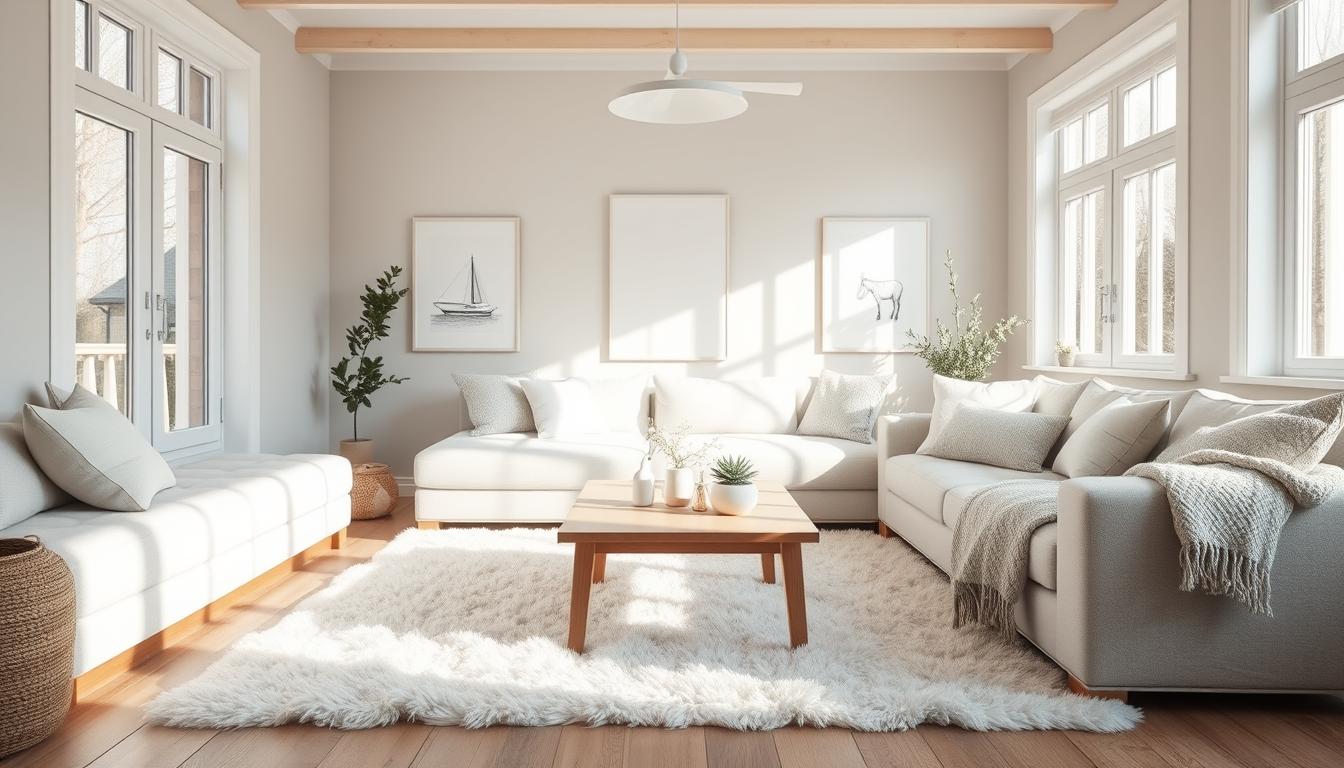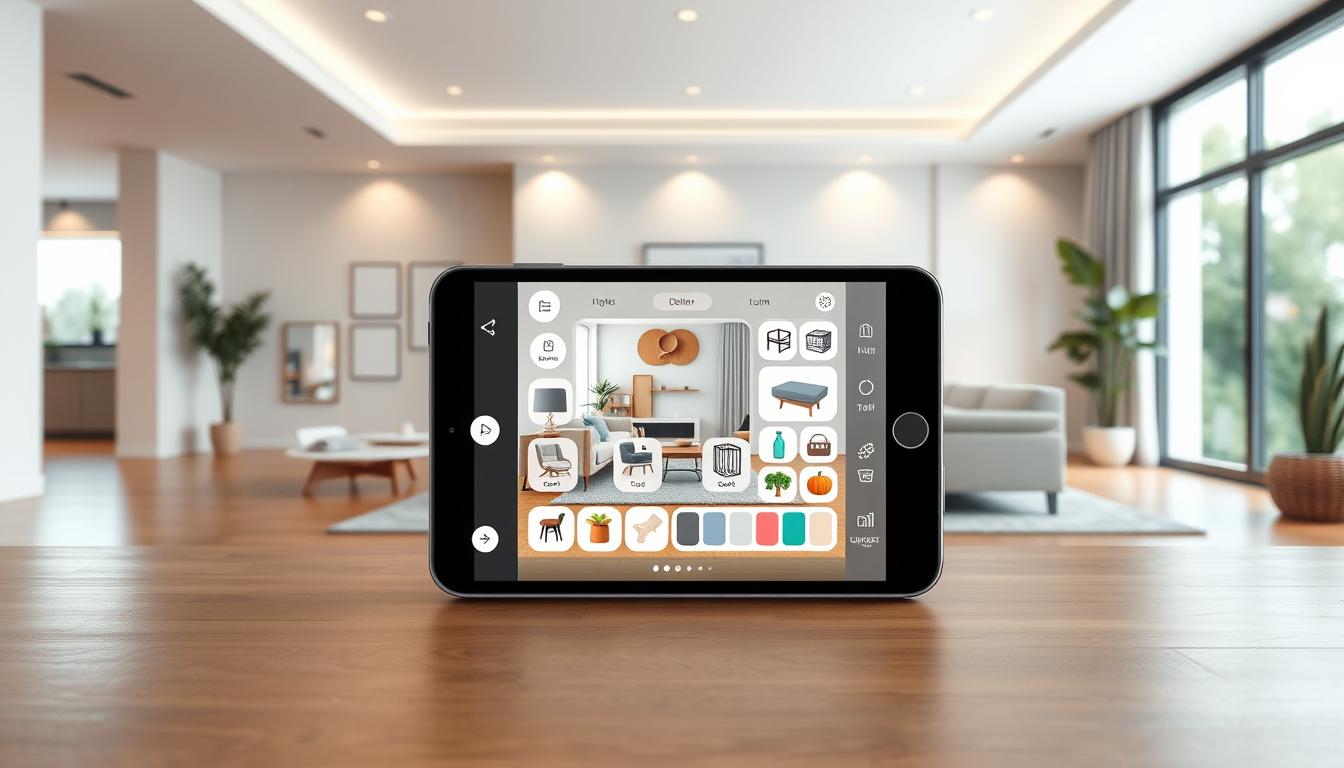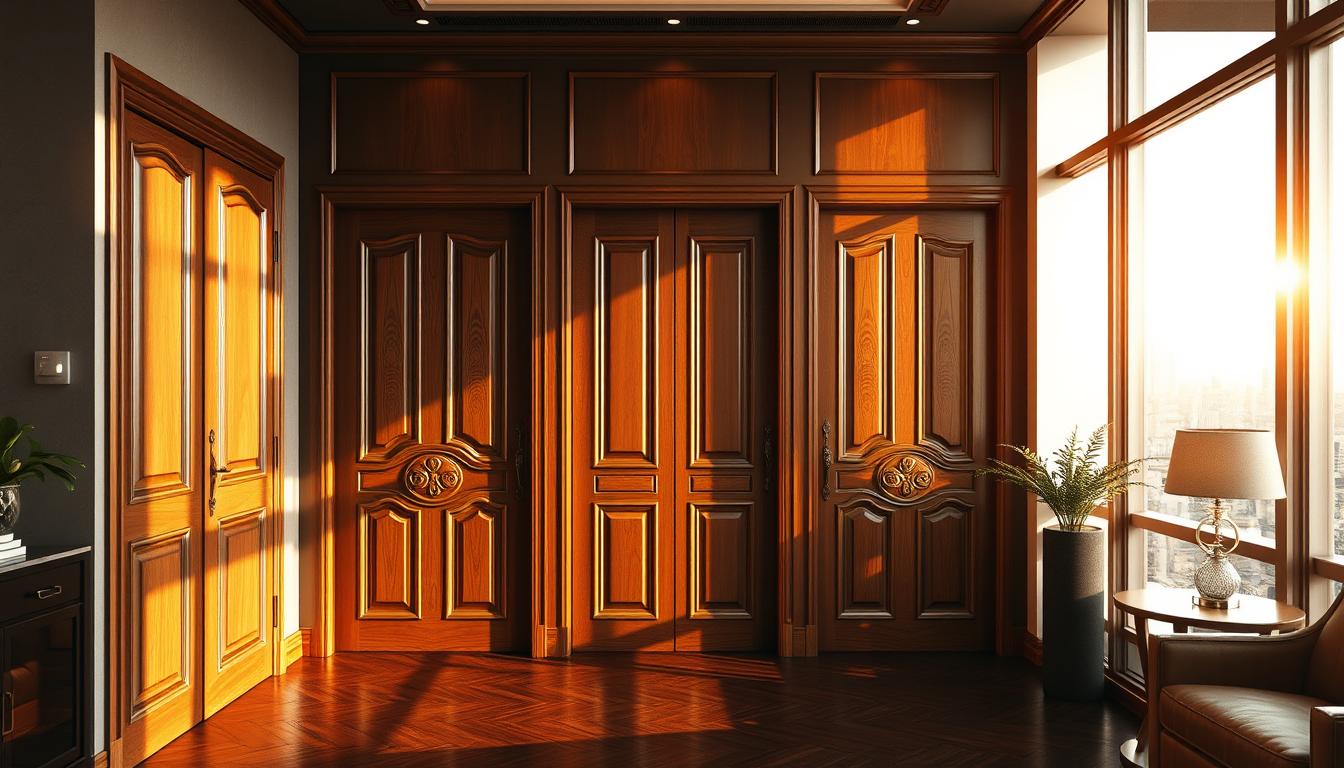Did you know Scandinavian decor is loved all over the world? It’s known for being simple yet cozy. This style makes any room feel warm and welcoming.
We’ll dive into the world of Scandinavian design. We’ll talk about its main parts and how to add it to your home. You’ll learn about its origins, the best colors and furniture, and more.
Key Takeaways
- Understanding the core principles of Scandinavian design
- Learning how to incorporate minimalist elements into your decor
- Discovering the importance of natural light and colors in Scandinavian decor
- Exploring practical tips for choosing the right furniture
- Creating a cozy and inviting atmosphere with Scandinavian design
Understanding Scandinavian Home Interior Design
Scandinavian home interior design is deeply rooted in the region’s culture and love for nature. It emerged from the harsh climate and the need for simple, functional spaces.
Origins and Influences
The design of Scandinavian homes is shaped by the region’s culture and geography. The long, dark winters led to the creation of cozy, functional spaces. Nordic style decor focuses on comfort, simplicity, and a connection to nature.
The natural world’s influence is seen in the use of wood and stone. Large windows and plenty of greenery also bring the outdoors in.
Key Principles of Design
The core principles of Scandinavian design are:
- Minimalism: It focuses on simplicity to create calm and clarity.
- Functionality: Every piece of furniture and decor must have a purpose, making the space both beautiful and practical.
- Connection to Nature: It incorporates natural materials, colors, and elements to bring the outdoors in.
By following these principles, Scandinavian design creates spaces that are both beautiful and comfortable. It results in a minimalist Scandinavian design that is stylish and livable.
Essential Elements of Scandinavian Design
Scandinavian design focuses on minimalism, natural textures, and a neutral color palette. These elements create a peaceful and welcoming home atmosphere. Let’s explore each of these key components.
Minimalism in Scandinavian Homes
Minimalism is a core part of Scandinavian design. It’s not just about simplicity. It’s about making a home calm and clear. By removing clutter and focusing on what’s essential, Scandinavian homes feel serene. Minimalist Scandinavian furniture is both functional and beautiful, with clean lines and no extra decorations.
- Clean lines and minimal ornamentation
- Functional furniture that serves multiple purposes
- A clutter-free environment that promotes relaxation
Natural Materials and Textures
Wood, wool, and linen are key in Scandinavian design. They add warmth and texture, making spaces interesting. Using natural materials also links the home to nature, creating a sense of unity. Wooden furniture and floors are common, along with wool blankets and linen drapes.
Neutral Color Palettes
The Scandinavian color scheme is all about neutrality, with lots of whites, grays, and beiges. This color choice lets furniture and decor stand out. It also makes it easy to add color with accessories, keeping the space balanced and harmonious.
“A neutral color palette is not just aesthetically pleasing; it’s also a practical choice for creating a sense of calm in the home.”
Choosing the Right Colors for Your Space
In Scandinavian design, colors are key to setting the mood of a room. The right colors can make a space feel bigger, cozier, or more welcoming. Traditional Scandinavian colors often stick to neutral tones. These colors offer a clean, minimalist look for other design elements.
Color Schemes that Work
Neutral colors are a big part of Scandinavian design. Shades like white, beige, and gray are common. They bring calm and serenity, and make rooms look brighter and bigger.
Design expert, Jane Smith, says, “Neutral tones are pleasing to the eye. They also let you add different textures and patterns easily.”
Think about the light in your space when picking colors. Rooms with lots of natural light can handle cooler tones. Rooms with less light might look better with warmer neutrals.
How to Use Accent Colors
Neutral colors are the base of Scandinavian design, but accent colors add personality. Blues and greens are favorites for adding a touch of nature. Start with small amounts – like a throw pillow or vase – to add color without overwhelming the space.
“Accent colors should enhance, not overpower, the overall design. A well-placed accent can draw the eye to a beautiful piece of furniture or a unique architectural feature.”
Importance of Light in Design
Light is crucial in Scandinavian design. Natural light makes spaces feel more inviting and reduces the need for artificial light. Artificial light, with warm tones, can make a space cozy, even in cold months.
Using different light sources – like overhead, table, and floor lamps – creates a layered lighting effect. This adds depth and warmth to a room.
Furniture Selection for Scandinavian Interiors
Furniture is key in Scandinavian design, focusing on both looks and use. The right pieces can turn a space into a cozy, welcoming area that shows off Nordic style decor.
Functional and Aesthetic Furniture
Choosing furniture that looks good and works well is crucial in Scandinavian design. It’s about finding items that are both useful and add to the room’s beauty. For example, a stylish and comfy sofa can be the heart of a living room, showing off Scandinavian living room ideas.
Iconic Scandinavian Furniture Brands
Some brands are known for their Scandinavian design, offering top-notch furniture. IKEA, Muuto, and Fritz Hansen are leaders in quality and style. They have furniture that can help you get a true Scandinavian feel in your home.
Multipurpose Furniture Solutions
In Scandinavian design, furniture that does more than one thing is prized. Think storage ottomans, extendable dining tables, and nesting coffee tables. These items save space and make your living areas more flexible and stylish, perfect for today’s homes.
Lighting in Scandinavian Home Design
In Scandinavian homes, lighting is more than just light. It’s a key part of the design. The right lighting makes a space feel welcoming and cozy, even in the long, dark winters of Nordic countries.
Types of Lighting Fixtures
Scandinavian design uses many lighting fixtures for a layered look. You’ll find overhead lights, table lamps, and floor lamps. Pendant lights are big hits, known for their simple, minimalist style.
Table lamps add a soft glow, perfect for both task lighting and creating a cozy feel. The choice of lights shows Scandinavian design’s values: simplicity, function, and a love for natural materials.
Natural Light Maximization
Scandinavian homes make the most of natural light, crucial in winter. They have big windows to let in as much light as possible. Sheer curtains or blinds filter the light, cutting glare but keeping the room bright.
Reflective surfaces like light-colored walls and floors also help. They bounce natural light around, making the room feel brighter and more open.
Importance of Warm Lighting
Warm lighting is key in Scandinavian homes for a cozy feel. In cold, dark months, it makes spaces feel more comfortable and relaxing. This is done with lamps and LED bulbs that give off a warm glow.
Lighting placement is also important. For example, a table lamp in a cozy reading nook makes it feel more inviting.
Creating an Inviting Atmosphere
Scandinavian interior design focuses on creating a warm and welcoming space. It’s about making a home feel cozy and inviting. We achieve this by using elements that add texture, warmth, and personality.
Cozy Textiles and Accessories
Textiles are key in Scandinavian design, adding warmth and texture. Throws, rugs, and pillows in natural materials like wool and cotton are essential. They bring color, texture, and invite touch, making a space feel cozy and welcoming.
For example, a wool throw blanket can make a minimalist sofa feel warmer. A plush area rug can also define a seating area and add warmth. The goal is to pick textiles that are both functional and visually appealing.
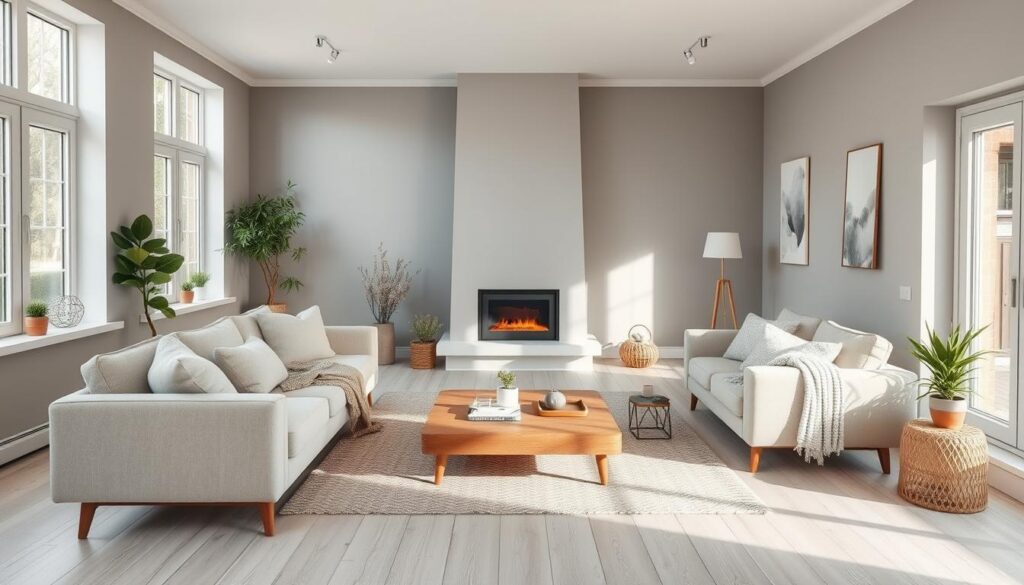
Incorporating Greenery and Plants
Adding greenery and plants is a great way to make a Scandinavian home inviting. Plants bring in a natural element, purify the air, and add vibrancy. From succulents to ferns, there’s a wide variety of plants that can thrive indoors.
When picking plants, think about the lighting and how much care they need. Snake plants are good for dark spots, while spider plants do well in bright areas. Plants can enhance our homes’ beauty and make them more welcoming.
Personal Touches in Your Decor
Personal touches make a house feel like home. In Scandinavian design, these can include artwork, decorative objects, and family heirlooms. They add character and make a space feel more personal and inviting.
Displaying personal items like vintage collectibles, family photos, or handmade crafts is a good idea. These items add interest and tell a story, making your space unique and personal.
| Element | Purpose | Examples |
|---|---|---|
| Cozy Textiles | Add warmth and texture | Throws, rugs, pillows |
| Greenery and Plants | Bring in a natural element | Succulents, ferns, snake plants |
| Personal Touches | Add character and personality | Artwork, decorative objects, family heirlooms |
Room-Specific Design Tips
In Scandinavian design, we focus on making spaces that are both beautiful and useful. Each room has its own needs. By understanding these, we can make homes that are both lovely and practical.
Living Room Ideas
The living room is the heart of the home, where we spend time with loved ones. To make a Scandinavian-style living room, think about using minimalist decor and functional furniture. Here are some tips:
- Choose a neutral color palette for a calm feel.
- Add natural textures like wood and wool.
- Go for furniture that does more than one thing, like a storage ottoman.
It’s also key to let in lots of natural light. Use sheer curtains or blinds to let sunlight in. This makes the room feel bigger and more welcoming.
Bedroom Design Essentials
The bedroom should be a peaceful retreat. In Scandinavian design, bedrooms are simple and clutter-free. This focus on comfort and calm is key. Here’s how to achieve it:
- Use soothing colors like soft grays or whites.
- Invest in quality bedding and linens for comfort.
- Keep clutter down with storage like under-bed drawers.
Adding plants or fresh flowers can also make the room feel more natural and cozy.
Kitchen and Dining Strategies
Kitchens in Scandinavian design are warm and welcoming. They’re the heart of the home for meals and gatherings. To create a Scandinavian kitchen, focus on being simple and functional. Here are some tips:
- Choose a minimalist look with clean lines and simple cabinets.
- Use natural materials like wood for countertops or flooring.
- Warm lighting makes the space cozy.
For the dining area, pick a table that’s big enough for gatherings. Add comfortable seating and good lighting. A Scandinavian dining area is all about simplicity and comfort, making meals enjoyable.
By following these design tips for each room, we can build a home that follows Scandinavian design principles. These include being functional, simple, and connected to nature.
Scandinavian Design on a Budget
You don’t have to spend a lot to bring Scandinavian design into your home. Affordable decor, DIY projects, and thrift store finds can help. This way, you can create a beautiful and functional space without spending too much.
Affordable Decor Solutions
Scandinavian design is all about minimalism, making it easy to find affordable decor. Use natural materials like wood and rattan for furniture. They add warmth and texture to your space. Look for minimalist Scandinavian design pieces at stores.
A simple wooden coffee table or a rattan basket can add Nordic style to your living room. Here are some budget-friendly ideas:
- Shop during sales or clearance sections
- Opt for second-hand or vintage items
- Use items you already have in a new way
DIY Options for Cost-Effective Design
DIY projects can add a personal touch to your Scandinavian-inspired home. Look for projects that use natural elements and simple designs. For example, you can make a beautiful wall hanging with dried branches and simple tools.
“The best design is the one that is so simple it becomes invisible.” –
Some DIY ideas include:
- Making your own throw pillows using natural fabrics
- Creating a gallery wall with black and white prints
- Upcycling old furniture with a fresh coat of paint
Thrift Store Finds
Thrift stores are great for finding nordic style decor without spending a lot. Look for simple, functional pieces that fit your Scandinavian design.
| Item | Original Price | Renovated Cost |
|---|---|---|
| Vintage Wooden Chair | $20 | $50 (after repainting) |
| Rattan Basket | $5 | $5 (no renovation needed) |
| Old Desk | $30 | $80 (after refinishing) |
Being creative and resourceful can help you achieve a beautiful Scandinavian-inspired home on a budget. It’s all about simplicity, functionality, and natural beauty.
Sustainable Practices in Scandinavian Design
Scandinavian design is all about being green. It shows the region’s big commitment to taking care of the environment. This is seen in the choice of materials, saving energy, and backing local artists.
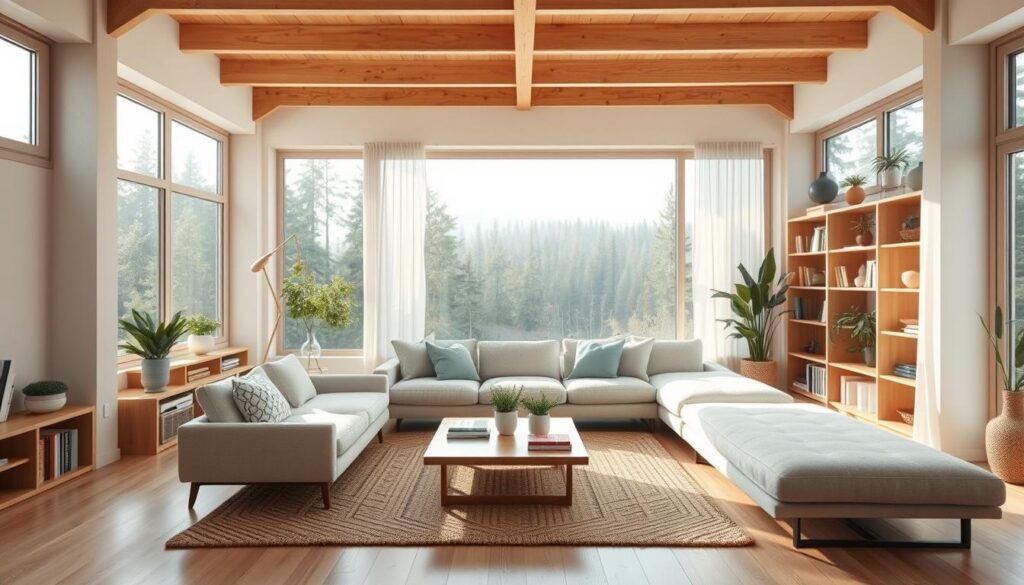
Eco-Friendly Materials
Using green materials is key in Scandinavian design. They choose wood that’s been sustainably harvested, recycled metals, and natural fibers. This helps the planet a lot.
Recently, more than 30% more green materials are being used. This shows how serious Scandinavia is about being eco-friendly.
“The use of sustainable materials is not just a trend; it’s a fundamental shift in how we approach design.” –
Energy Efficiency and Design
Scandinavian design also focuses on saving energy. Homes are made to be both beautiful and energy-smart. They use special insulation, energy-saving windows, and smart tech.
| Energy Efficiency Measure | Benefit | Scandinavian Adoption Rate |
|---|---|---|
| Advanced Insulation | Reduces heat loss by up to 50% | 85% |
| Energy-Efficient Windows | Minimizes energy consumption | 90% |
| Smart Home Technologies | Optimizes energy use in real-time | 75% |
Supporting Local Artisans
Backing local artists is a big part of Scandinavian design. It keeps old skills alive and cuts down on carbon emissions. It also helps local communities grow and feel connected to their heritage.
- Promotes traditional craftsmanship
- Reduces carbon footprint
- Fosters community development
In short, Scandinavian design is a great choice for a green home. It uses eco-friendly materials, saves energy, and supports local artists. This way, we can all help make the future greener.
How to Mix Scandinavian Design with Other Styles
Mixing Scandinavian furniture with other styles makes your space unique and eclectic. Scandinavian design is simple and functional. It’s a great base for many design combinations.
Industrial Meets Scandinavian
Combining Scandinavian design with industrial elements creates a striking contrast. This adds depth to your space. Use industrial materials like metal and reclaimed wood with Scandinavian furniture.
For example, pair a sleek Scandinavian sofa with industrial lighting or metal accents. This mix creates a unique look. The goal is to balance industrial’s cold feel with Scandinavian’s warmth.
| Element | Scandinavian Design | Industrial Style |
|---|---|---|
| Materials | Wood, Fabric | Metal, Reclaimed Wood |
| Color Palette | Neutral, Pastels | Monochromatic, Metallic |
| Lighting | Soft, Warm | Harsh, Exposed |
Bohemian Influences
Adding bohemian elements to Scandinavian design adds coziness and personality. Bohemian style is known for vibrant colors, eclectic patterns, and natural textures. It complements Scandinavian minimalism well.
To add bohemian touches, use colorful textiles, unique accessories, or plants with your Scandinavian furniture. This mix creates a warm, inviting space that feels both curated and relaxed.
Modern Eclectic Combinations
Scandinavian design can also be mixed with modern eclectic elements for a contemporary look. Modern eclectic style combines different elements like modern furniture, abstract art, and bold colors. This creates a visually interesting space.
To get a modern eclectic look, start with a neutral Scandinavian base. Then, add modern pieces that introduce new textures, colors, and shapes. This way, you can personalize your space while keeping it cohesive.
By mixing Scandinavian design with other styles, you can make a home that shows your personality and style. Whether you prefer industrial, bohemian, or modern eclectic, the key is to balance contrasting elements in a way that feels harmonious and inviting.
Trends in Scandinavian Home Interior Design
Scandinavian home interior design is all about trends. These trends shape our living spaces. They focus on functionality, simplicity, and a connection to nature.
What’s Popular Right Now
Modern Scandinavian design blends old and new. The Scandinavian color palette is key, with whites, grays, and beiges. Natural wood and colorful textiles add flair.
Some top trends include:
- Incorporating sustainable materials and practices
- Using natural textures like wood, wool, and linen
- Embracing minimalism while adding personality through unique decorative pieces
- Maximizing natural light with sheer curtains and smart window placements
Predictions for Future Trends
Scandinavian design will keep evolving. We’ll see more eco-friendly materials and smart home tech. Designs will focus on well-being too.
| Trend | Description | Impact |
|---|---|---|
| Sustainable Materials | Increased use of recycled and eco-friendly materials | Reduced environmental footprint |
| Smart Home Technology | Integration of technology for enhanced comfort and efficiency | Improved living experience |
| Wellness-Focused Design | Designs that promote physical and mental well-being | Healthier living environments |
Influential Designers to Follow
Many designers are shaping Scandinavian design. Key names include:
- Arne Jacobsen, known for his iconic furniture designs
- Henning Larsen, who has made significant contributions to architectural design
- Contemporary designers like Frederikke Mejdahl and Ditte Hammer, who are pushing the boundaries of modern Scandinavian design
Following the latest trends and insights from these designers helps us update our homes. We can make our living spaces stylish and meaningful.
Conclusion: Embracing Scandinavian Design in Our Homes
Scandinavian home interior design is more than a trend. It’s a way of life that values simplicity and a connection to nature. By embracing Nordic style decor, we can make our homes beautiful and personal.
Key Principles to Remember
To bring Scandinavian design into our homes, we need to focus on minimalism and natural materials. Neutral colors also play a key role. These elements help create a calm and serene atmosphere in our spaces.
Personalizing Your Space
We can still make our homes unique while following Scandinavian design principles. Adding unique textiles, greenery, and personal touches is key. This mix of style and personality makes Nordic style decor so appealing.
Exploring Further
If you want to learn more about Scandinavian home interior design, there are many resources out there. Design blogs and furniture stores like IKEA are great places to start. By exploring and learning, we can create a home that truly reflects our values and style.

